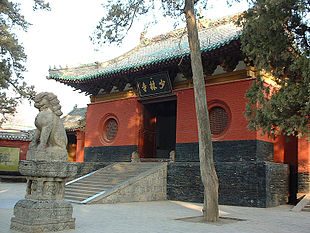Shaolin Monastery
![]()
The title of this article is ambiguous. For other meanings, see Shaolin (disambiguation).
34.5020305556112.93Coordinates: 34° 30′ 7.3″ N, 112° 55′ 48″ E
Shaolin (Chinese 少林, pinyin Shàolín) is the name of a Buddhist monastic order in China and its members. Likewise, Shaolin refers to the order's original monastery, located on Songshan Mountain in the town of Dengfeng in Henan Province in the heart of China. It is famous for its martial arts style 少林拳(Shàolínquán, "Fist of Shaolin"), better known as "Shaolin Kung Fu". The monastery is also considered the birthplace of historic Chan Buddhism, the precursor of Zen (kor. Seon, viet. Thien, sanskrit Dhyana).
The name Shaolin Temple (Chinese 少林寺, Pinyin Shàolín Sì) is also borne by a number of other monasteries in the People's Republic of China, Korea (Sorim), Indochina and Japan (Shorinji).
In the West, the order and the monastery have become known mainly through the film character of the monk "Kwai Chang Caine" (played by David Carradine) from the 1970s television series Kung Fu and from numerous other Easterns, even if the portrayal of the monks usually does not have much to do with reality. Various "Shaolin" show groups have also become well known, touring many countries with their acrobatic performances and impressive skills, although the show mainly demonstrates modern wushu and aesthetic showmanship by specially hired performers who have little to do with the monks of the monastery.
In the 1980s, the Shaolin order reopened or founded a number of temples in China and in the West. It sees itself as a school of Chan Buddhism; the martial arts are considered part of Buddhist practice.

Shaolin Temple at Song Shan
Name
The name of the temple is in Chinese 少林寺 Shàolín Sì. The character 少 shǎo or shào carries the meaning "little" or "young", but is also the name of Mount Shaoshi (少室山), at whose northern foot the monastery stands. The character 林 lín means "forest", 寺 si means "temple". The name Shaolin can thus be translated either as "temple in the young forest", but probably reflects the location as "temple in the forest on Mount Shaoshi".
The Southern Shaolin Monastery
Legends tell of a second, southern Shaolin monastery in Fujian, which is said to have existed until the 18th century. It is possible that the legend about the destruction of the Shaolin Monastery during the reign of Emperor Kangxi refers to this monastery. The Southern Shaolin Monastery is considered to be the place of origin of the Southern Chinese martial arts styles (e.g. Wing Chun, Hung Kuen).
The exact historical location of the southern monastery is unknown and is claimed by at least three sites in China.
In Quanzhou, in the southeastern province of Fujian, Shaolin Monastery was officially founded during the Tang Dynasty (618-907). One tradition says that monks from the northern Shaolin Temple came to the south to help fight pirates. Other traditions say that the monks fled from the north after the fall of the Ming Dynasty in the 17th century.
Questions and Answers
Q: Where is the Shaolin Monastery located?
A: The Shaolin Monastery is located at Song mountain of Dengfeng, near Zhengzhou City, Henan Province, China.
Q: Who is currently leading the Shaolin Monastery?
A: The Shaolin Monastery is currently led by the Venerable abbot Shi Yǒngxìn.
Q: When was the Shaolin Monastery founded?
A: The Shaolin Monastery was founded in the 6th century.
Q: What is the Shaolin Monastery known for?
A: The Shaolin Monastery is known for being the Holy Ground of Kung Fu and for being the Mahayana Buddhist monastery perhaps best known to the Western world.
Q: Is the Shaolin Monastery still active?
A: Yes, the Shaolin Monastery is still active and is led by the Venerable abbot Shi Yǒngxìn.
Q: What province in China is the Shaolin Monastery located in?
A: The Shaolin Monastery is located in the Henan Province of China.
Q: What mountain is the Shaolin Monastery located on?
A: The Shaolin Monastery is located on Song mountain.
Search within the encyclopedia